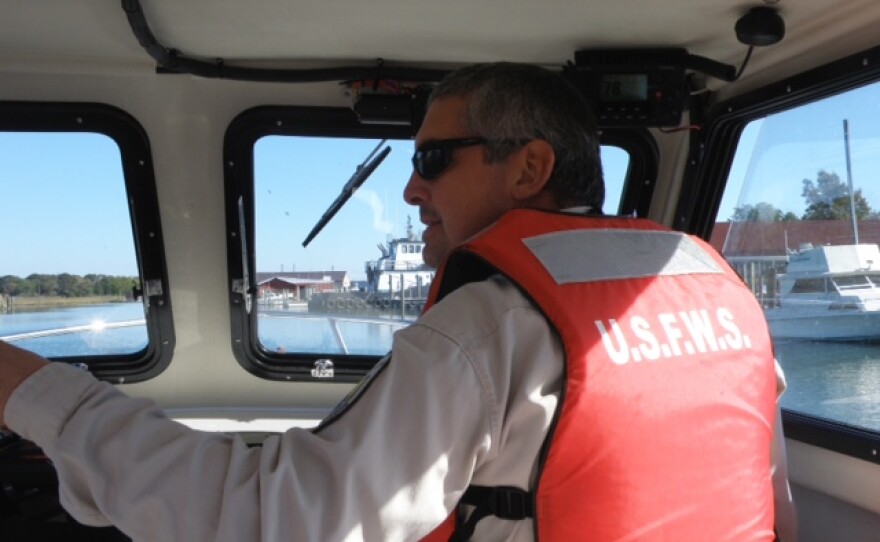Recently, we’ve reported on the issue of coastal erosion in the First State– how climate change, rising seas and coastal storms impact Delaware, the nation’s lowest lying state. We’ve looked at the problems it creates not only for the shoreline, but for the state’s Inland Bays and marshes in places like the Prime Hook Wildlife Refuge – and how it could cause problems for threatened species that use them like the red knot. We’ve also told you about new methods being used to combat the problem in Delaware, including something called living shorelines.
Delaware is not alone in fighting this battle and in this week’s Enlighten Me - as part of our new collaboration with WYPR in Baltimore, Virginia Public Radio and others – we bring you a look at how its playing out in elsewhere on the Delmarva Peninsula.
Contributor Pamela D’Angelo tells us that in Maryland some of the Chesapeake Bay’s pristine wildlife refuges are drowning, casualties of erosion and the rising waters caused by climate change. And now, the U.S. Fish and Wildlife Service is using Superstorm Sandy money and the latest science there to restore and protect two of Maryland’s prized refuges – in ways similar to what we see here in the First State.
When the Blackwater National Wildlife Refuge was established on Maryland's Eastern Shore in 1933, biologists wanted to protect the huge waterfowl population. Today, it's the 28,000 acres of marshes and forests inhabited by vulnerable species like black rail, saltmarsh sparrow and the Delmarva fox squirrel.
In the middle of the refuge from a platform overlooking acres of marsh, and the Blackwater River, Fish and Wildlife biologist Matt Whitbeck points to trees slowly dying from encroaching salt water.
You can see open water that used to be tidal marsh, dead snags in the marsh, so that was a forest not that long ago," said Whitbeck. "There is no question that these habitats are moving across the landscape at a great speed. So how do we work with this natural process rather than fighting it? That's the big question."
Fish and Wildlife, partnered with The Conservation Fund and local chapters of the National Audubon Society to map where the largest marshes could migrate without running into roads or future developments.
"Where are these large expanses of marsh likely to be in 2050 and 2100 and how can we work with adjacent landowners, work with NGOs to protect those marsh migration corridors to ensure that these habitats have a place to migrate to," said Whitbeck.
Already some lands near Blackwater have been set aside for conservation. With $5 million, mostly from Hurricane Sandy funds, the refuge will build 25 acres of new salt marsh by dredging remnants of the old marsh that washed into the Blackwater River.
To get to Fish and Wildlife's other project you need a boat. On the north side of Smith Island out in the Chesapeake Bay, at Glen Martin National Wildlife Refuge, it's no longer a question of how to save the marshes because the $9 million project there is nearly done.
Two excavators sit precariously at the edge of the bay placing the last boulders that are part of a 21,000 foot living shoreline to protect the marshes from future storms. Floating offshore are tugboats and half a dozen barges piled high with sand, boulders, dump trucks and other equipment. The contractor, from Massachusetts, is the same company that mastered Boston's Big Dig.
"So the plan is to have the bulk of the construction done by November 15," said Whitbeck. "So we'd like to get all the rock in place, the sand all placed, and then let the acting wind and wave energy kind of shape that sand over the course of the winter and then we'd come back in the spring next year and then we'd vegetate it.
The living shoreline will protect wildlife habitat including underwater grasses home to crabs and fish from which the majority of the 270 Smith Islanders make their living. The refuge is also a buffer between the bay and the town of Ewell. Pastor Rick Edmund has lived in Ewell more than a decade preaching at the island's three Methodist Churches.
"We'll reap benefits because it will delay the erosion coming into the populated areas, at least Ewell. Rhodes Point and Tylerton it doesn't really help. Tylerton has a bulkhead, Rhodes Point is the place that's in need now," said Edmund.
And, while you can't step foot on the Glen Martin National Wildlife Refuge you can kayak the channels and three towns around it. Smith Islanders host a kayaking trail for tourists to paddle and view rare nesting birds, the state reptile, the Diamondback Terrapin, as well as watching the disappearing working watermen.
Reporting for this story was made possible by a fellowship with the Institute for Journalism & Natural Resources.





